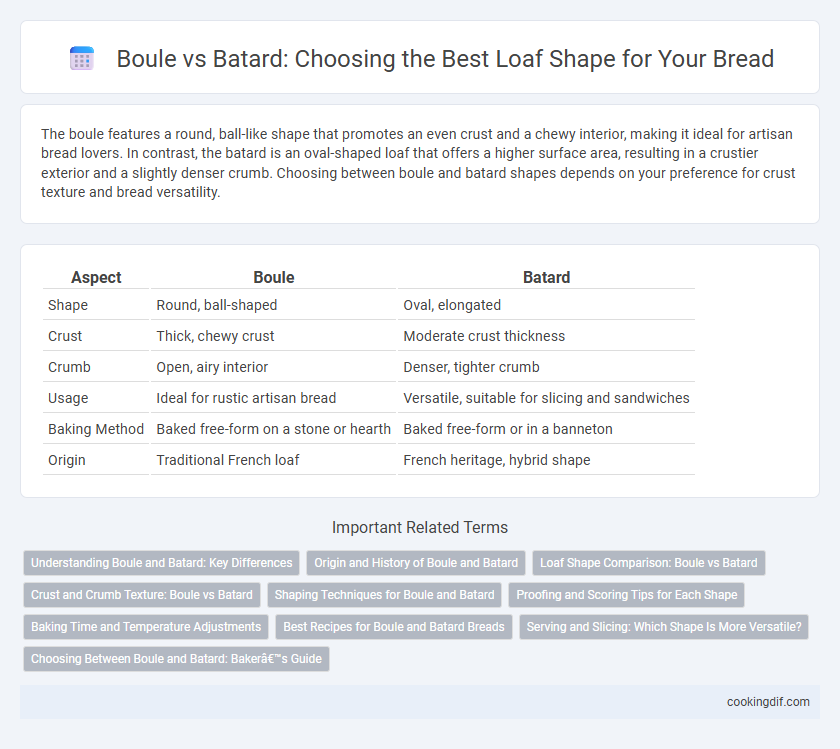The boule features a round, ball-like shape that promotes an even crust and a chewy interior, making it ideal for artisan bread lovers. In contrast, the batard is an oval-shaped loaf that offers a higher surface area, resulting in a crustier exterior and a slightly denser crumb. Choosing between boule and batard shapes depends on your preference for crust texture and bread versatility.
Table of Comparison
| Aspect | Boule | Batard |
|---|---|---|
| Shape | Round, ball-shaped | Oval, elongated |
| Crust | Thick, chewy crust | Moderate crust thickness |
| Crumb | Open, airy interior | Denser, tighter crumb |
| Usage | Ideal for rustic artisan bread | Versatile, suitable for slicing and sandwiches |
| Baking Method | Baked free-form on a stone or hearth | Baked free-form or in a banneton |
| Origin | Traditional French loaf | French heritage, hybrid shape |
Understanding Boule and Batard: Key Differences
Boule, characterized by its round, ball-like shape, offers a rustic crust and a chewy interior ideal for artisanal bread. Batard features an elongated, oval form providing a balance between crust thickness and crumb structure, making it versatile for slicing. Both loaf shapes influence baking time and texture, impacting the bread's overall flavor and usability in different culinary contexts.
Origin and History of Boule and Batard
The boule, originating from France, takes its name from the French word for "ball" due to its round, rustic shape rooted in traditional country baking. The batard, also French, features an elongated oval shape that lies between a boule and a baguette, historically developed to provide a versatile loaf suitable for slicing or tearing. Both shapes reflect centuries of French baking heritage, with the boule dating back to medieval times and the batard emerging as a practical adaptation.
Loaf Shape Comparison: Boule vs Batard
The boule features a round, dome-shaped loaf with a thick, crusty exterior and a chewy crumb, ideal for artisan-style bread. The batard has an elongated oval shape, offering a greater surface area for a crustier crust and a more uniform crumb structure. Choosing between boule and batard depends on desired crust texture and slicing preferences for different bread applications.
Crust and Crumb Texture: Boule vs Batard
Boule bread features a round shape with a thick, chewy crust and a dense, moist crumb, ideal for hearty sandwiches and dipping. Batard, with its elongated oval form, offers a thinner, crispier crust and a lighter, airier crumb, making it versatile for slicing and toasting. The crust thickness and crumb texture differences stem from their shapes, influencing baking time and heat distribution.
Shaping Techniques for Boule and Batard
Boule and batard differ primarily in their shaping techniques, influencing both texture and crust development. Boule is formed into a tight, round shape by folding the dough inward multiple times to build surface tension, essential for an even crumb and robust crust. Batard, an oval-shaped loaf, is created by flattening and folding the dough lengthwise before rolling it into a compact vehicle, promoting a slightly lighter crumb than the boule.
Proofing and Scoring Tips for Each Shape
Boule loaves require even proofing to maintain their round shape and benefit from deep, curved scoring to promote controlled expansion. Batard loaves need a slightly longer proofing time to develop a more elongated form, with scoring typically done in a single or double slash along the length to guide oven spring. Proper scoring and proofing tailored to each shape ensure optimal crust texture and crumb structure.
Baking Time and Temperature Adjustments
Boule loaves typically require a baking temperature around 450degF (232degC) for 30-40 minutes due to their round, thicker shape, which retains heat longer and ensures an even crumb. Batard loaves, being oval and slightly flatter, often bake at a slightly higher temperature, about 460degF (238degC), for a shorter duration of 25-35 minutes to achieve a crispier crust without drying the interior. Adjusting time and temperature based on loaf shape helps optimize the crust-to-crumb ratio and overall texture in artisanal bread baking.
Best Recipes for Boule and Batard Breads
Boule bread features a round, rustic shape ideal for hearty soups and stews, with best recipes emphasizing a thick crust and airy crumb achieved through a long fermentation process. Batard bread, shaped like an elongated oval, offers a balanced crust-to-crumb ratio perfect for sandwiches and toast, with top recipes highlighting a slightly softer crust and chewy texture from a moderate proofing time. Both loaves utilize similar hydration levels and can be tailored with sourdough or yeasted doughs to enhance flavor profiles and rise.
Serving and Slicing: Which Shape Is More Versatile?
Boule's round shape offers uniform slices ideal for dipping and serving with spreads, while batard's elongated form provides varied slice sizes suited for sandwiches and toasting. Batard's shape makes it easier to achieve thin, even slices, enhancing versatility for different culinary uses. Choosing between boule and batard depends on preferred serving style and slicing requirements for meals.
Choosing Between Boule and Batard: Baker’s Guide
Boule and batard differ primarily in shape, with boule being a round, ball-shaped loaf and batard an elongated oval. The boule's shape promotes a thick crust and a chewy interior ideal for rustic, artisanal breads, while the batard offers a larger surface area for a crispier crust and more uniform crumb structure. Bakers select between boule and batard based on desired crust texture, crumb density, and slicing utility for specific bread types or culinary applications.
Boule vs Batard for loaf shape Infographic

 cookingdif.com
cookingdif.com